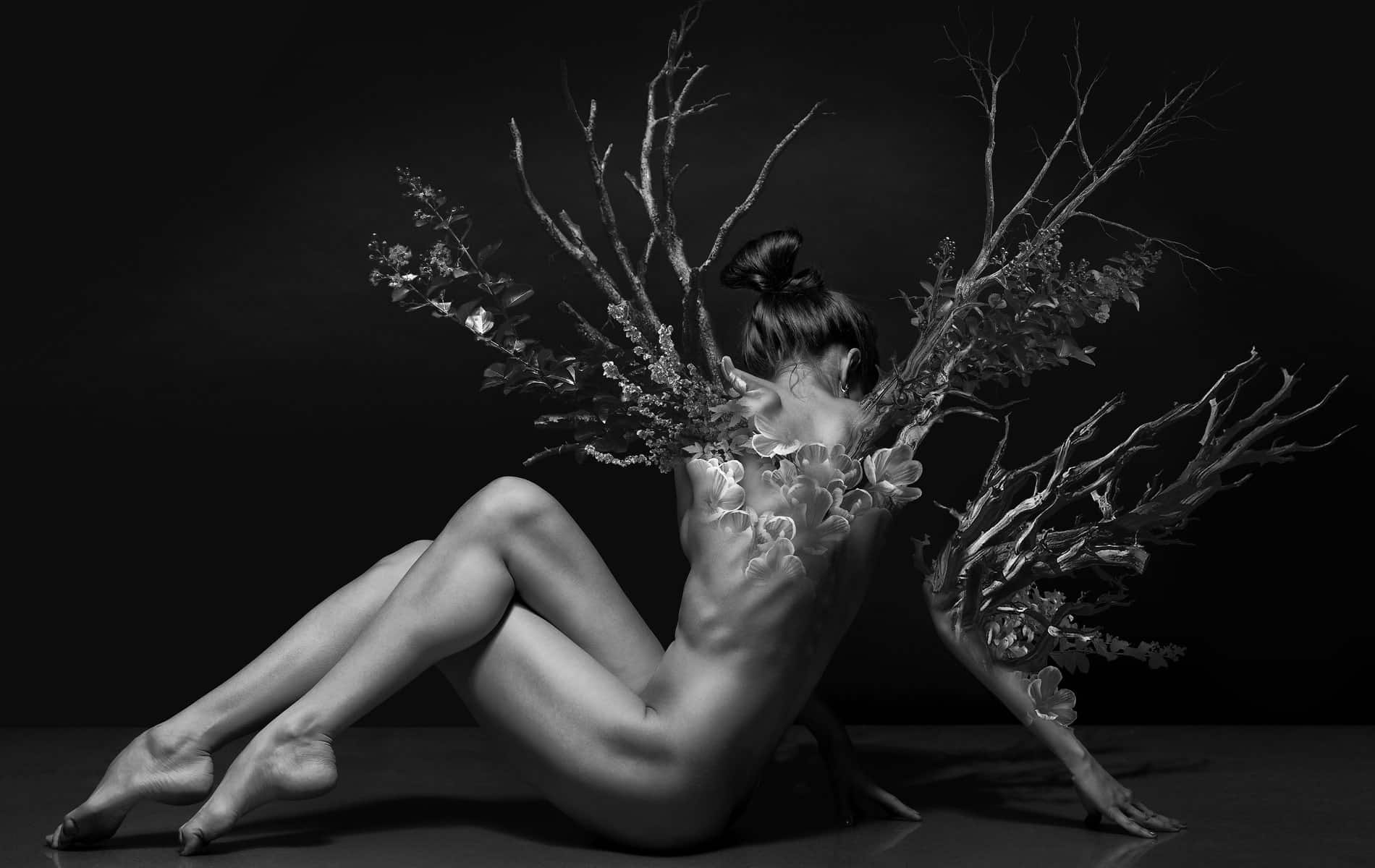
VIE_Magazine_SEP22_article_Charles_Bentley_HERO-min
Pose 2, from Bentley’s limited-edition collaboration with photographer Anton Belovodchenko
Tehcno-Art Is Here
A Combustible Fusion
By Addie Strickland | Photography courtesy of Charles Bentley
Art, in many ways, is a living being with emotions and influence. Thousands of years old, the world of art has evolved with the times but maintained its distinct breath and presence in society. The latest update within the intersection of art and technology is NFTs, or non-fungible tokens. With NFTs, art in its physical state is being transformed into a cryptographic asset in digital blockchains. As new as the concept is, the fact remains that art has already proved throughout history that it is malleable with the times. A prominent Brooklyn-based multimedia artist and illustrator, Charles Bentley has entered the online art world and captured a global audience. Bentley creates masterful fusions of nature and dreams, from paintings to exclusively digital art. His determination to develop his craft throughout his career and with the changing times of technology has amassed over twenty-two thousand followers on Instagram.
The cultivation of an artistic spirit is quietly born and patiently grown. During his childhood and teenage years, Bentley recalls major creative points of inflection that contributed to the broad base of inspiration and experience he now pulls from in his process. He explains, “In a way, my current work is a synthesis of inspirations from both my parents. My mother had a career in the fashion industry, and my father was a former professional photographer turned landscape architect.” An impressive fourth-grade painting of an ancient Greek terra-cotta pot was only the beginning for this young artist.

Pose 3, a piece from Bentley’s collaboration with photographer Anton Belovodchenko
In the seventh grade, while on a family trip to Paris, Bentley found the driving spark of his artistic inspiration—a book. Written almost entirely in French, except for the title, Black Book Graffiti, it covered the underground European street-art scene. The key inspiration factor came from the many examples of “wildstyle” graffiti typography, which unlocked an unexplored world for Bentley. He spent the next few years exploring the world of street art, typography, graphic design, and illustration. Bentley says, “I was hooked!” From there, he expanded his horizon to include the burgeoning graffiti community on YouTube, trading stickers and competing in sketch competitions. “Graffiti is a gateway drug into the design world,” he laughs.
Bentley’s interest in the graffiti world eventually pivoted and led him to illustrations. “These illustrations and design experiments led me to the path of Adobe Photoshop and Illustrator.” With skills unknown to most and the correct software, his career path and passion were fundamentally determined.
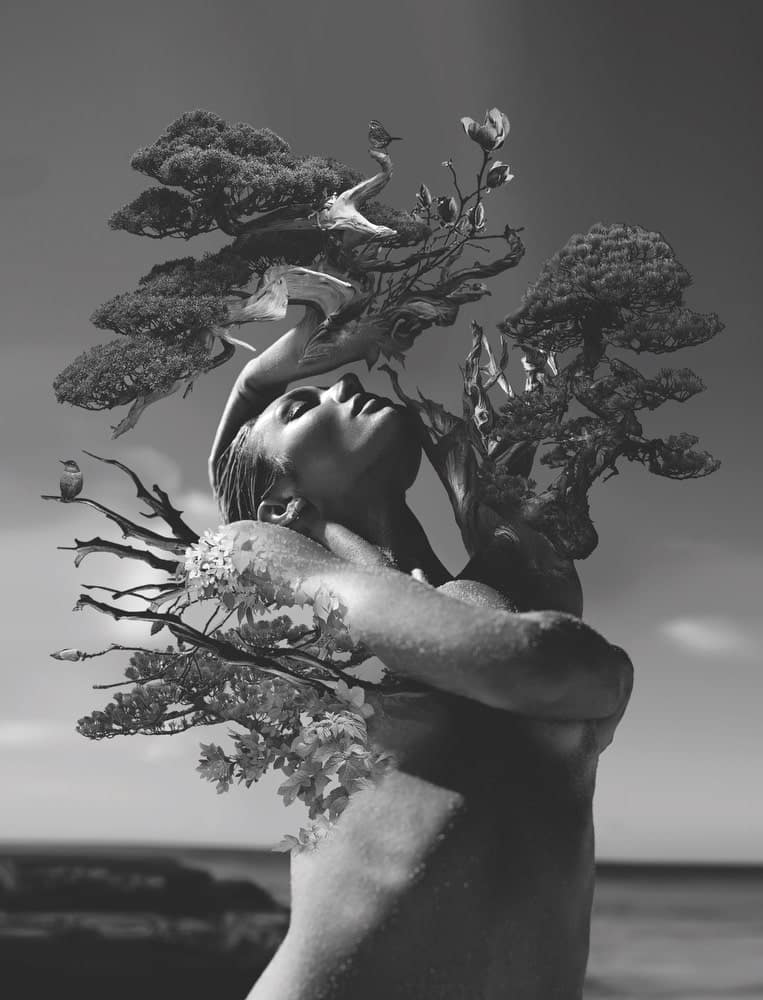
Bentley’s digital interpretation of model Candice Swanepoel photographed by Adam Franzino
In a way, my current work is a synthesis of inspirations from both my parents. My mother had a career in the fashion industry, and my father was a former professional photographer turned landscape architect.
After graduating in 2016 from Tulane University with a bachelor’s degree in fine arts and a focus on printmaking, Bentley started working in digital design for a retailer in New York. For two years, he worked in the corporate world, as he puts it, “daydreaming about making my art all the time.” With high expectations, it can be hard to nail down the best or “perfect idea” for one’s career, but he took the leap and made a digital collage of a Chanel No. 5 bottle (featured in the July 2019 issue of VIE). This marked the beginning of his artistic empire.
For the next couple of years, Bentley created hundreds of digital collages inspired by Andy Warhol’s prints. Soon after, his focus became fashion-inspired, which is what he makes today. The thematic continuity of nature throughout his work symbolizes meanings ranging from the scope of human nature itself to personal significance. He recalls, “Each branch I use in these works comes from a particular cedar grove on the tip of an island sprawling out in front of northern Lake Huron in an archipelago called Les Cheneaux Islands. We spread my father’s ashes in the water right off this grove of cedars. He was a fundamental part in the development of my appreciation for art and the beauty of the natural world.”
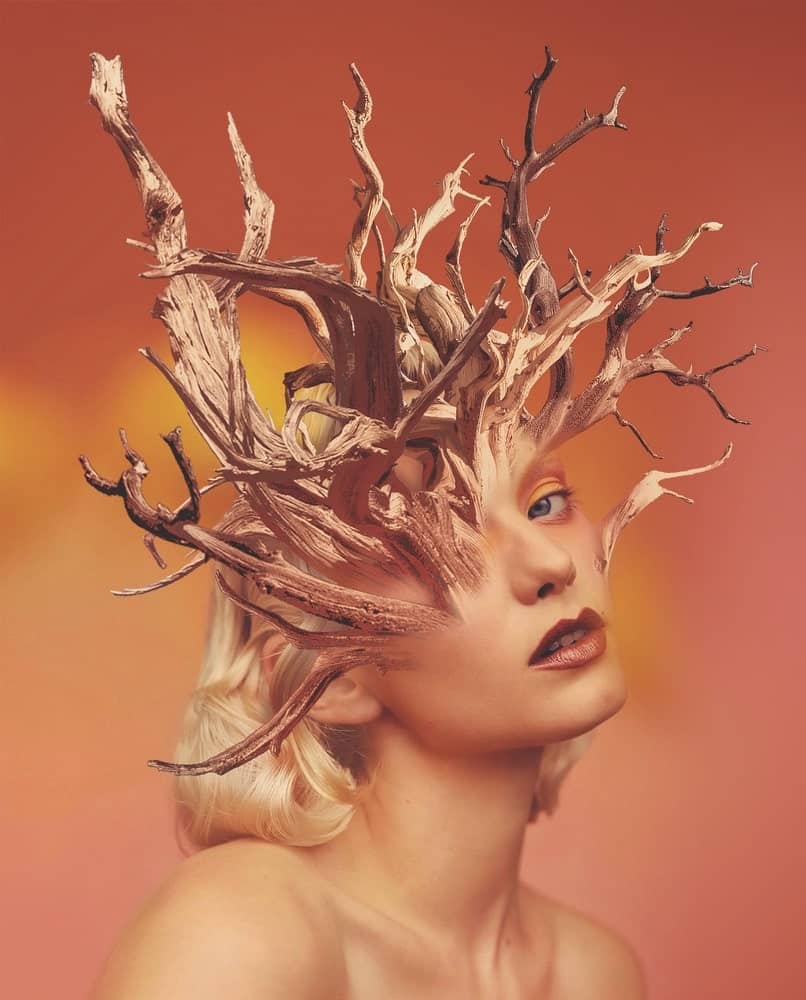
Model Katie Moore sports a Charles Bentley whimsical nature-inspired digital makeover. | Photo by David Urbanke
To evolve is to adapt to an ever-changing standard of what’s acceptable, but artists follow the rhythm and movement of art in its simplest form. It’s often an artist’s calling to create a repetitive sense of movement that challenges the world to slow down and reflect. Bentley adds, “I suspect many of us, especially in regard to creativity, aren’t completely transparent with ourselves.” Yet, in a tumultuous world, at least one constant remains—the function and beauty of art. Every artist, knowingly or not, is compelled by idiosyncrasies and incorporates personal symbolism into their creations; however, art is not complete without the viewer’s interpretation. Social media and other digital platforms allow more people than ever to see an artist’s work, offering countless opportunities for shared perspectives.
The line between art and technology thins by the day. This evolution of art is not merely an adaptation to change, nor is it an appropriation by society; it is an extension of the interaction and participation between an artist’s creation and its beholder. Bentley explains, “Artists and brands have learned that it’s much more valuable not simply to have fans but to interact with them and develop a community around your work. This idea of building a community is one of the main ways the NFT space is changing the art world.”
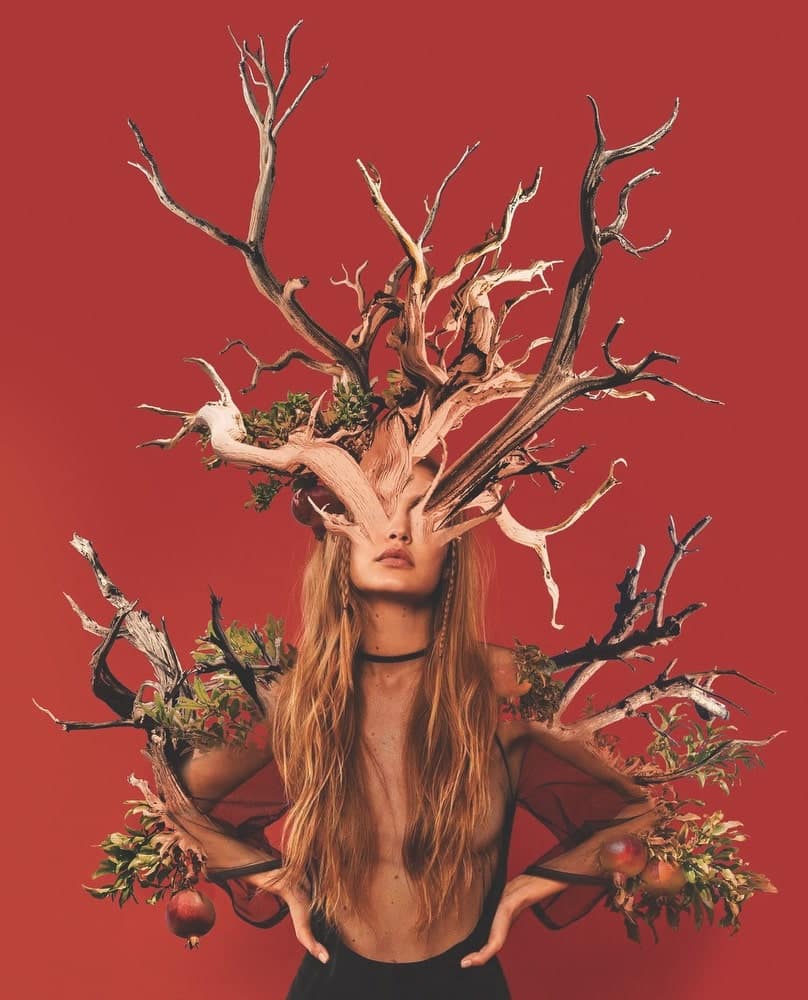
Photo by Zoey Grossman
Each branch I use in these works comes from a particular cedar grove on the tip of an island sprawling out in front of northern Lake Huron in an archipelago called Les Cheneaux Islands.
The NFT platform engages a different demographic in the art world, allowing a more level playing field in who can attain an original piece of art. In addition to revolutionizing the trading model in the art market, it enables more focus on the visual perspective of a piece. “One thing I’m interested to see develop, as I’m working on a project with this in mind, is how the traditional art world will use NFT technology to augment the viewer’s experience,” Bentley comments. NFTs will not replace the traditional art industry because, at their core, NFTs are financial instruments. “A large part of what the NFT community is, even from a visual perspective, lies outside the art world.” As stated, it’s believed they will revolutionize the art market and appeal primarily to a new, more web-knowledgeable demographic.
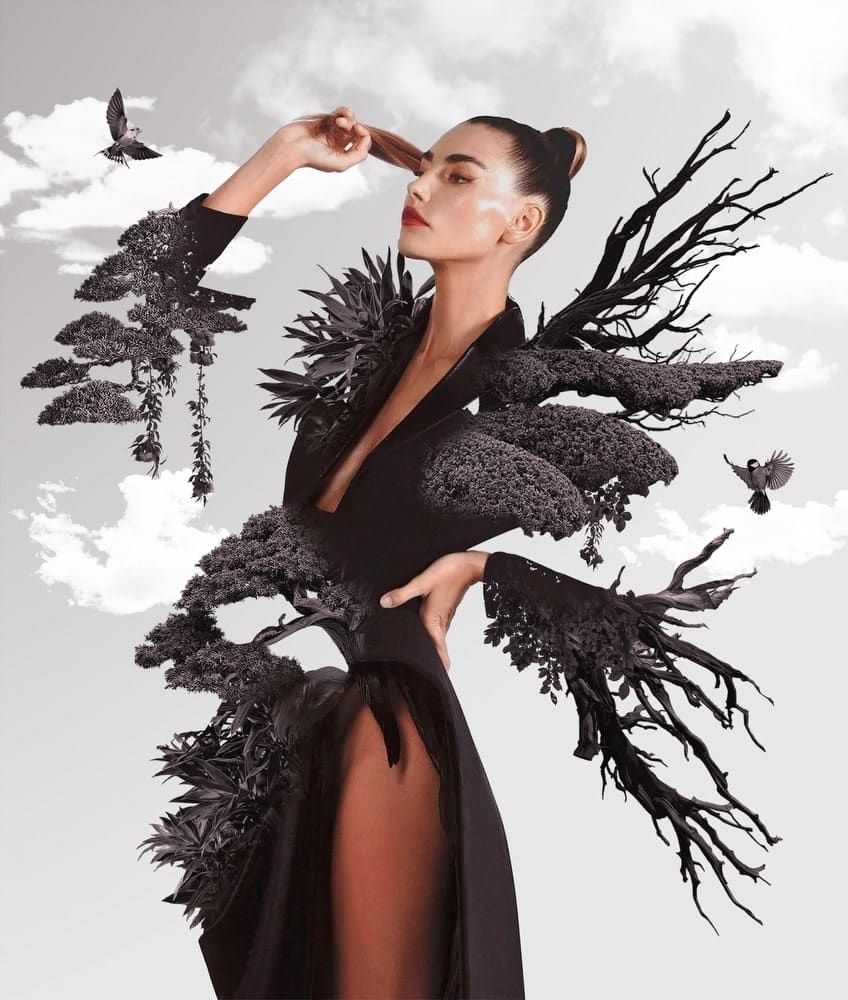
A beautiful piece from Bentley’s collaboration with Ukrainian model Alina Baikova and photographer Jean-Baptiste Fort; this artwork is available as an NFT.
Artists and brands have learned that it’s much more valuable not simply to have fans but to interact with them and develop a community around your work.
The future of art and this technology is built on interactivity, says Bentley. “What most interests me about the relationship between art and technology, specifically with NFTs, is incorporating them into experiences so that art viewers will be able to interact with art in a unique, documentable way.” There are always growing pains with changing technology, but there are great rewards as well. In addition to interactivity—an avenue that Bentley will further experiment with in future projects—he believes that people will utilize the digital world more to display art. “I think it may be more common to have large digital frames in your home where you can display NFT collections. People are already doing similar things with their smart TVs.”
Audience participation was relatively unheard of for thousands of years in the art industry, but now you can hardly enter a gallery without having to sing or dance or tap on a keyboard for the artwork to be complete. New technology opens a gateway to opportunities while challenging the norms. The full experience of artwork includes interpretation by the viewer; with new technology, this interpretation is influenced not only by shapes, textures, and colors on canvas but also by movements, sounds, and, most importantly, the ability to interact with a piece.
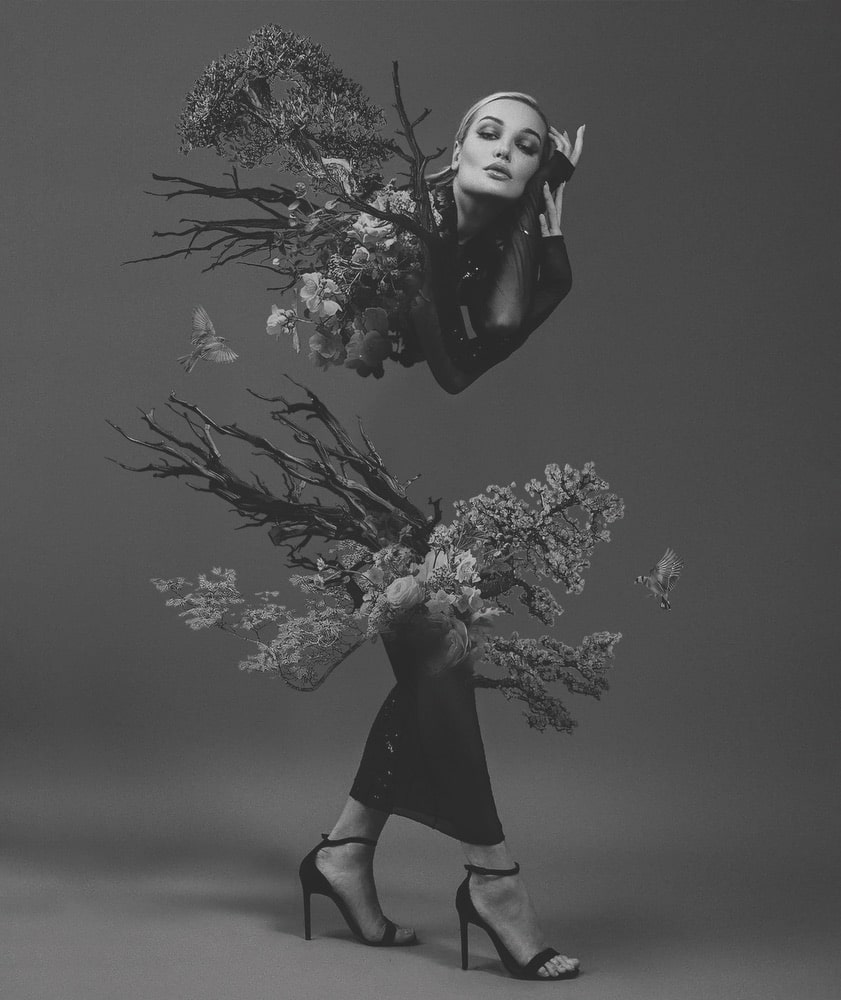
Another NFT collaboration by Charles Bentley, featuring model Daria Konovalova photographed by Julia Sariy
What most interests me about the relationship between art and technology, specifically with NFTs, is incorporating them into experiences so that art viewers will be able to interact with art in a unique, documentable way.
Art is probably one of the truest signs of the times, ebbing and flowing with the latest trends, social commentaries, and mediums while remaining loyal to the artist’s vision. Bentley will exemplify this through a broad technological spectrum of applications for art in his upcoming body of work, Material Technology. This project will be a multiphase, digital-meets-physical NFT project. He will sell physical pieces along with accompanying NFTs, providing primary or exclusive access to later phases of the project or incentivizing participation with the interactive artworks on display. With an understanding of the market and an uncommon creative brilliance, Charles Bentley amusingly neglects the average standards of art and pushes the boundaries through technology and his broad base of experience.
— V —
To learn more about Charles Bentley, visit CharlesBentleyDesigns.SquareSpace.com or follow him on Instagram @charlesbentley.
Share This Story!
KEEP UP WITH THE LATEST STORIES FROM VIE
















































































































































